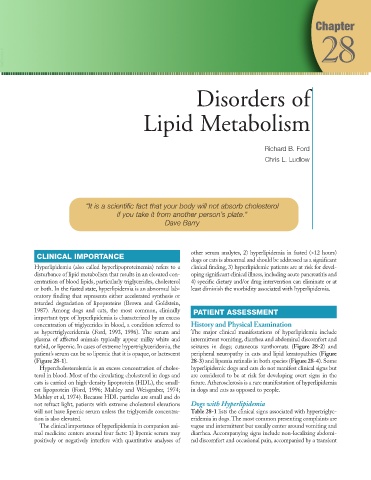Page 527 - Small Animal Clinical Nutrition 5th Edition
P. 527
Chapter
28
VetBooks.ir
Disorders of
Lipid Metabolism
Richard B. Ford
Chris L. Ludlow
“It is a scientific fact that your body will not absorb cholesterol
if you take it from another person’s plate.”
Dave Barry
other serum analytes, 2) hyperlipidemia in fasted (>12 hours)
CLINICAL IMPORTANCE
dogs or cats is abnormal and should be addressed as a significant
Hyperlipidemia (also called hyperlipoproteinemia) refers to a clinical finding, 3) hyperlipidemic patients are at risk for devel-
disturbance of lipid metabolism that results in an elevated con- oping significant clinical illness, including acute pancreatitis and
centration of blood lipids, particularly triglycerides, cholesterol 4) specific dietary and/or drug intervention can eliminate or at
or both. In the fasted state, hyperlipidemia is an abnormal lab- least diminish the morbidity associated with hyperlipidemia.
oratory finding that represents either accelerated synthesis or
retarded degradation of lipoproteins (Brown and Goldstein,
1987). Among dogs and cats, the most common, clinically PATIENT ASSESSMENT
important type of hyperlipidemia is characterized by an excess
concentration of triglycerides in blood, a condition referred to History and Physical Examination
as hypertriglyceridemia (Ford, 1993, 1996). The serum and The major clinical manifestations of hyperlipidemia include
plasma of affected animals typically appear milky white and intermittent vomiting, diarrhea and abdominal discomfort and
turbid, or lipemic. In cases of extreme hypertriglyceridemia, the seizures in dogs; cutaneous xanthomata (Figure 28-2) and
patient’s serum can be so lipemic that it is opaque, or lactescent peripheral neuropathy in cats and lipid keratopathies (Figure
(Figure 28-1). 28-3) and lipemia retinalis in both species (Figure 28-4). Some
Hypercholesterolemia is an excess concentration of choles- hyperlipidemic dogs and cats do not manifest clinical signs but
terol in blood. Most of the circulating cholesterol in dogs and are considered to be at risk for developing overt signs in the
cats is carried on high-density lipoprotein (HDL), the small- future. Atherosclerosis is a rare manifestation of hyperlipidemia
est lipoprotein (Ford, 1996; Mahley and Weisgraber, 1974; in dogs and cats as opposed to people.
Mahley et al, 1974). Because HDL particles are small and do
not refract light, patients with extreme cholesterol elevations Dogs with Hyperlipidemia
will not have lipemic serum unless the triglyceride concentra- Table 28-1 lists the clinical signs associated with hypertriglyc-
tion is also elevated. eridemia in dogs.The most common presenting complaints are
The clinical importance of hyperlipidemia in companion ani- vague and intermittent but usually center around vomiting and
mal medicine centers around four facts: 1) lipemic serum may diarrhea. Accompanying signs include non-localizing abdomi-
positively or negatively interfere with quantitative analyses of nal discomfort and occasional pain, accompanied by a transient

